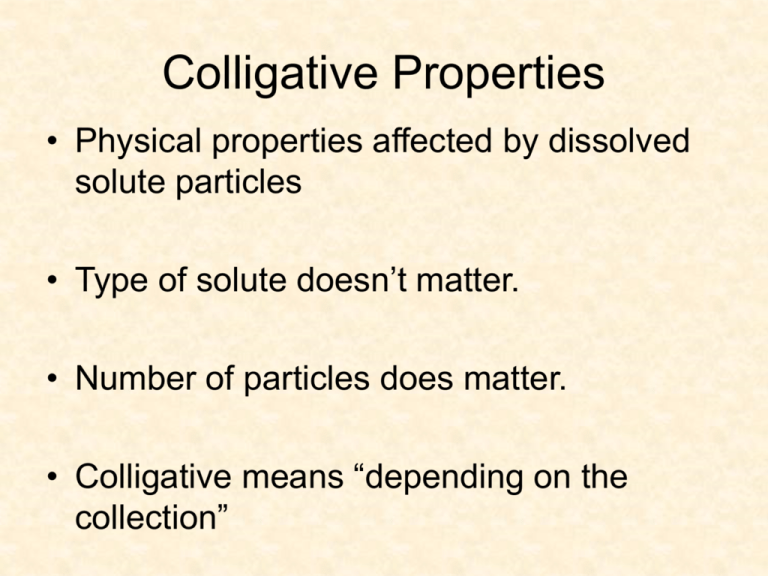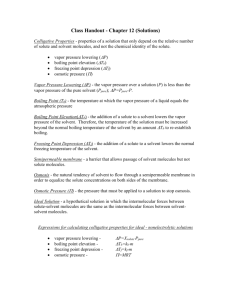Colligative Properties
advertisement

Colligative Properties • Physical properties affected by dissolved solute particles • Type of solute doesn’t matter. • Number of particles does matter. • Colligative means “depending on the collection” Colligative Properties • Occur with nonvolatile solutes – ones that have little tendency to become a gas • 4 colligative properties: – Vapor pressure lowering – Boiling point elevation – Freezing point depression – Osmotic pressure Colligative Properties • Electrolytes are molecules that ionize or fall apart when in solution; nonelectrolytes do not fall apart or ionize • Electrolytes will have a greater impact on the 4 colligative properties • Why? – Sugar (C12H22O12) remains as one molecule when dissolved. – Salts like MgCl2 dissociate in water so one mole of MgCl2 actually forms 3 moles of ions. Vapor Pressure Lowering • Pressure in a CLOSED container exerted by the particles of liquid that have escaped and become gas particles • Greater number of escaped particles = greater vapor pressure • The addition of a solute LOWERS the vapor pressure – WHY? • The solute molecules get in the way of the solvent molecules trying to escape at the surface of the liquid. Boiling Point Elevation • A liquid boils when it’s particles can escape as a gas (or when the vapor pressure is equal to the atmospheric pressure) • Ex: salt in water when cooking pasta antifreeze in radiators • When a solute is added, the boiling point is driven higher – WHY? • The solute molecules get in the way of the solvent molecules trying to escape at the surface of the liquid. Freezing Point Depression • A liquid freezes when its particles do not have enough energy to overcome the intermolecular forces between them. • So the molecules are pulled closer together and take on a defined shape. • When a solute is added, the freezing point is driven lower – WHY? • The solute molecules get in the way and make it harder for the solvent molecules to move closer and become a solid • Ex: salt & sand on icy roads ethylene glycol on icy airplanes Calculating b.p. elevation and f.p. depression • Because the type of solute doesn’t matter, you only need to know the amount of solute • Elevation & depression happen at a constant rate depending on the amount of solute added (number of moles) ∆ Tb = Kbm ∆ Tf = Kfm (where Kb & Kf are the constants) Try It • If you have .625 m aqueous solution with a nonvolatile, nonelectrolyte solute, what would the boiling point and freezing point be? Try It • Calculate the freezing point and boiling point of a solution that contains 105.4 g NaCl dissolved in 750.3 ml H2O. Osmotic Pressure • Osmosis is a natural process where the solvent flows across a membrane – always flows from where there is more solvent to where there is less solvent. • Adding solute to one side of the membrane will cause more solvent to flow that way. • This increases the osmotic pressure on that side of the membrane. • Ex: kidney dialysis uptake of nutrients by cells







